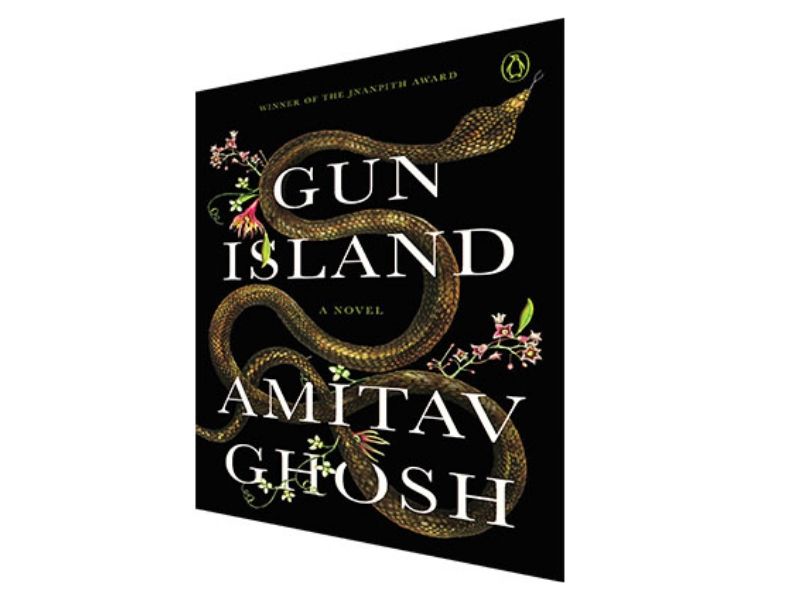Gun Island – Amitav Ghosh; Penguin Random House, Rs.699, Pages 287

Amitav Ghosh is back with a fictional work after he declared in The Great Derangement: Climate Change and the Unthinkable (2016) that “the age of global warming defies both literary fiction and contemporary common sense” and therefore, such improbabilities are rarely “accommodated in the deliberately prosaic world of serious prose fiction”.
Ghosh’s new novel – Gun Island spins a yarn that attempts to defy his own prognosis, while it is tenuously tied to his 2004 book The Hungry Tide, set in the Sunderbans marsh forests of West Bengal. Several characters — Nilima Bose, founder of the Badabon Trust of Lusibari; cetologist Piya, Moyna and Tipu, widow and son of Fokir; seasoned fisherman Horen Naskar — reappear in Gun Island. This novel weaves contemporary environmental concerns, border crossings and migration and human trafficking together against the backdrop of folk myths and resurgence of belief in extra-sensory perception.
The story-line features the narrator Dinanath Dutta, aka Deen, a folklorist and rare-books dealer based in Brooklyn, who visits Kolkata every winter and is drawn into investigating the lore of Bonduki Sadagar (gun merchant) and rediscovering his forgotten shrine in the Sundarbans, “the frontier where commerce and the wilderness look each other directly in the eye” and the “war between profit and nature is fought”.
However, although Ghosh’s latest oeuvre is a novel with a narrative storyline, it’s also a polemical tract on how urbanisation and climate change have wreaked havoc on this tiger and snake-infested marshland, prompting large-scale human migration in search of sustainable livelihoods. It recounts Tipu acting as an enabler who helps illegal emigrants to find new lives in Europe/Italy/Venice. Far-fetched though it may seem, a Venetian lagoon becomes a haven for Bangladeshis, a mirror image of the Sunderbans where Rafi, the grandson of a Capt. Ilyas who maintained the shrine that Deen visits, is a construction worker.
While recounting the legend of the Bonduki Sadagar, Ghosh takes readers back to folk stories featuring Manasa, the snake goddess of the Sunderbans who protects her followers and harms sceptical unbelievers like the gun merchant. The journey of the 17th century merchant is fraught with risks and adventures but recreates the cosmopolitan trade links that existed between Asia and Europe. Deen’s Venetian friend Cinta, professor Emerita at the University of Padova, unravels the puzzles that had intrigued him when he saw symbols and pictorial representations on the friezes in the shrine of Bonduki Sadagar. Although the answers to the riddles appear somewhat contrived, it traces the etymology of the word bundook (gun) to banadiq, the Byzantine name for Venice and is also associated with guns, hazelnuts and bullets in Arabic.
The old ghetto frequented by Jews like Ilyas, formerly a foundry for armaments, turns into a refuge of illegal immigrants from Bangladesh in more contemporary times. The journey of Captain Ilyas and Bonduki Sadagar is routed through Egypt and Turkey to Venice as almost like a magician, Cinta is able to establish these connections as she deciphers the Arabic equivalents of commonplace Bengali words and Hebrew alphabets in meaningless signs. In the first part of the novel, a legend that seemed a mere fantasy is rationally strung together as history and events and migrations are forcibly brought within the ambit of political and geographical explanations.
The second part of Gun Island is sited in Venice, a decaying old city that is the centre of the most wayward happenings and draws together an array of unconvincing characters. Deen’s encounter with Rafi is as mysterious as the story of Tipu being separated from his friend before finding his way through indefinable waits in ‘connection houses’ to the so-called Blue Boat of refugees, migrants and traffickers.
Tipu’s near-death experience from a king cobra snake-bite inside an abandoned shrine located in a Sunderban creek, finds a strange death echo on a California beach where a deadly yellow-bellied sea snake suddenly surfaces. A regional supernatural myth is twinned with a fall-out of climate change even as Deen is possessed by visions of slithering snakes and creepy spiders that strangely enough, materialise in urban spaces.
Unfortunately, a sustained effort to match the uncanny with factual realism often results in weirdly exaggerated situations. It draws together a journalist and clairvoyant, an illegal immigrant and a cetologist, media persons, a travel agent and a book seller on the ship Lucania, watching a strange weather phenomenon that has affected Italy — a deluge with rain and hail, gale-force winds and devastated forests. This natural upheaval quietens down only to reveal a “motley flotilla of vessels” and chartered boats carrying either right-wing anti-immigration groups or human rights activists who advocate the policy of live and let live. The confrontation of humans with nature and animals on the one hand, and human groups against seething xenophobia on the other, defines for Ghosh the contemporary age of the anthropocene.
Gun Island is fiction that tries to impact the grave effects of global warming, and the compelling need to take action. It tows along contemporary international concerns about border crossings and immigration. The plot unfolds more as a series of coincidences involving fictional characters and overpowering events. The story was in the legend of the gun merchant, the unravelling of which is unfortunately sucked out somewhere along the way.
Jayati Gupta
Also read: Internet age politics: How to win an Indian election

























